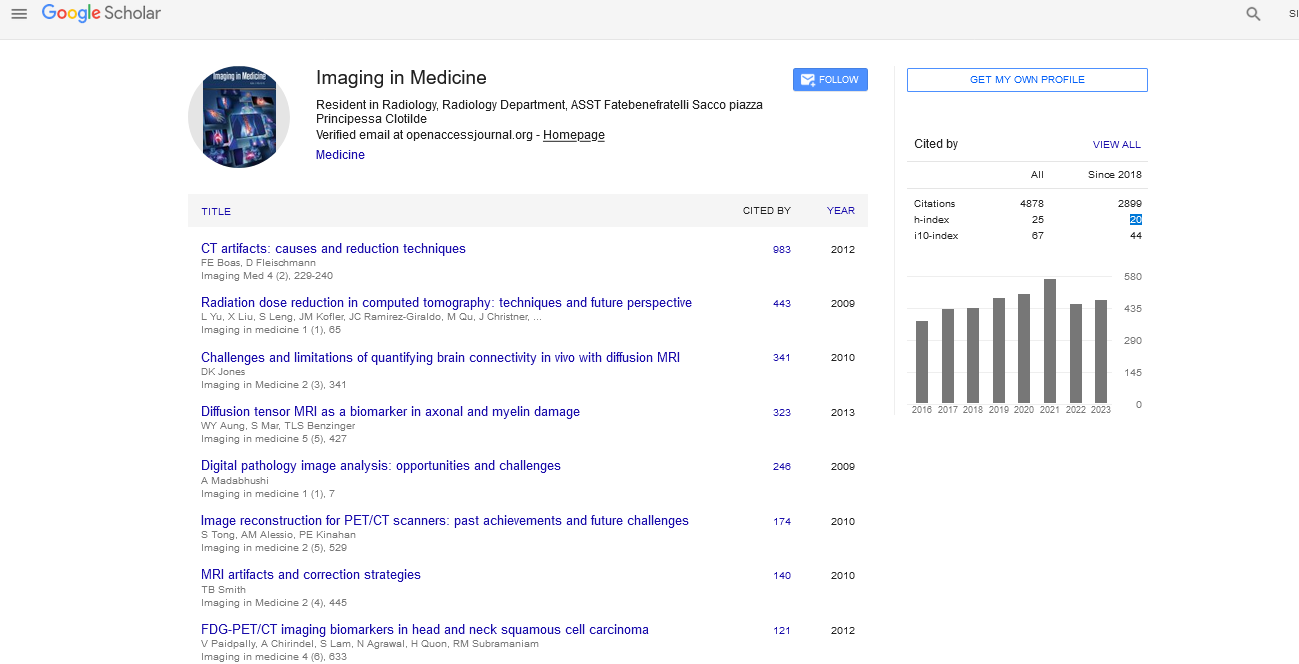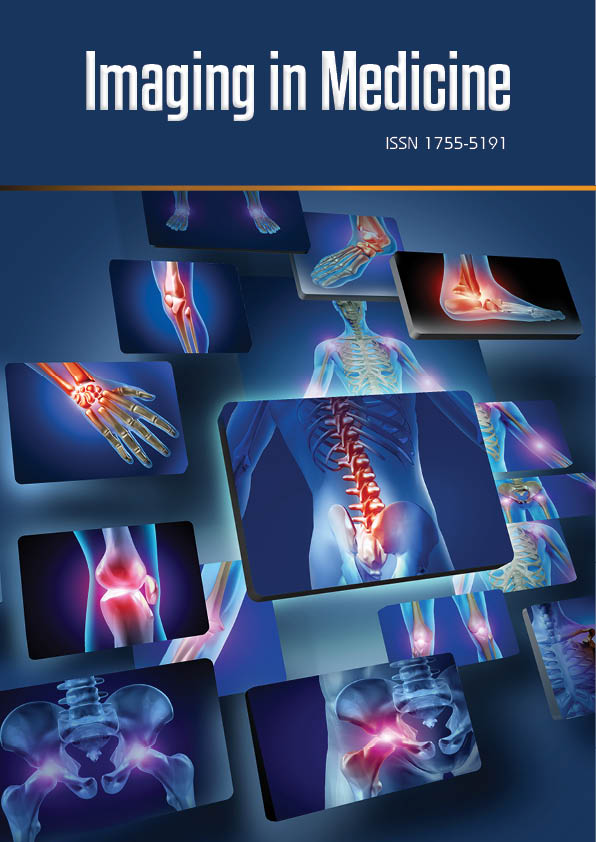Editorial - Imaging in Medicine (2012) Volume 4, Issue 3
Imaging studies as biomarkers of Parkinson disease
Darren Gitelman* and Tanya Simuni
1Northwestern University, Feinberg School of Medicine, 710 North Lake Shore Drive, Abbott 11th Floor, Chicago, IL 60611, USA
2Northwestern University, Feinberg School of Medicine, 710 North Lake Shore Drive, Abbott 11th Floor, Chicago, IL 60611, USA
- *Corresponding Author:
- Darren Gitelman
Northwestern University, Feinberg School of Medicine
710 North Lake Shore Drive, Abbott 11th Floor
Chicago, IL 60611, USA
Tel.: +1 312 908 8266
Fax: +1 312 908 5073
Email: d-gitelman@northwestern.edu
Abstract
Keywords
biomarker; MRI; Parkinson’s disease; PET; SPECT; ultrasound
The need for biomarkers
Parkinson’s disease (PD) is the second most common neurodegenerative disorder after Alzheimer’s disease, affecting over 1 million people in the USA [1]. PD is also the most common cause of parkinsonism, a clinical syndrome with a constellation of symptoms including bradykinesia, rigidity and resting tremor. The diagnosis of PD is based on a set of clinical criteria that focus on the motor signs of the disease [2]. However, diagnostic accuracy is only 90% even in the hands of movement disorders experts [3]. PD diagnosis is more prone to error early in the clinical course of the disease [4], even though the pathologic process leading to PD probably begins a decade or more before clinical signs are apparent. By the time patients are diagnosed, approximately 70–80% of striatal dopamine and over 50% of substantia nigra (SN) neurons have already been lost [5]. Likewise, monitoring PD progression and medication responses is also subject to error as it primarily relies on relatively coarse and somewhat subjective measures of motor performance.
“Imaging biomarkers have been among the most studied measures, and target a wide range of processes underlying the biology and pathology of Parkinson’s disease.”
While current treatment of PD is limited to symptomatic therapy, there is active research aimed at developing disease-modifying treatment options. Considering the long preclinical period, such interventions would have to be applied early in the course of the disease when fewer neurons have been compromised. Thus, defining criteria that enable early and accurate diagnosis, and for measuring the effects of treatment, are critical to developing more effective therapies. These criteria will require the validation and use of biomarkers or objective measures to establish the diagnosis (disease trait) and to track the pathologic biological processes (disease state) [6]. Sensitive biomarkers can also improve the power of clinical trials leading to faster and less costly drug development. An example of an effective biomarker has been the ability to measure HIV–1 viral load, which accelerated the development of drugs to treat AIDS [3].
A variety of premotor signs, such as the presence of olfactory dysfunction, sleep disturbances, changes in autonomic function, and mood disorders, have been documented, sometimes years before the onset of motor symptoms in PD [5]. These could serve as potential clinical biomarkers; however, none of them are very sensitive or specific for the preclinical identification of PD [5]. Additional genetic, serological and metabolic biomarkers, including measurement of a-synuclein and plasma urate, have been identified but not yet validated in tracking disease progression [3]. Imaging biomarkers have been among the most studied measures, and target a wide range of processes underlying the biology and pathology of PD. This editorial will briefly review the current state of structural and functional imaging as potential biomarkers of PD diagnosis and disease progression.
Imaging biomarkers in PD
SPECT & PET imaging
Ligands for PET and SPECT comprise a rich set of potential biomarkers as they target several preand post-synaptic mechanisms of dopamine processing. A comprehensive review can be found in the recent publication by Cummings et al. [7]. In brief, imageable presynaptic dopamine processing steps include decarboxylation of L-DOPA to dopamine by L-aromatic amino acid decarboxylase (AADC), measured by 18F–fluorodopa PET (18F–DOPA); storage of dopamine in presynaptic vesicles by the vesicular monoamine transporter type 2 (VMAT2), measured by 11C–dihydrotetrabenazine (DTBZ) PET or 18F–AV133 PET; and termination of dopamine’s action through reuptake by the membrane dopamine transporter (DAT), measured by a number of ligands of which 123I–ioflupane SPECT (DaTScan™) is now commercially available [8].
The interpretation of PET/SPECT imaging biomarkers can be complicated by compensatory changes in the underlying presynaptic dopamine mechanisms. For example, the upregulation of AADC in early PD may result in 18F–DOPA underestimating the degree of dopaminergic denervation. By contrast, downregulation of DAT, and the effects of medications and age, may lead to an overestimation of nigral cell loss by 123I–ioflupane SPECT [8].
All presynaptic ligands can accurately distinguish individuals with normal versus abnormal presynaptic dopaminergic function, but cannot discriminate between parkinsonian syndromes [3]. Thus, PET/SPECT imaging biomarkers can be used to increase the specificity of an early PD diagnosis especially for purposes of recruitment into clinical trials. For example, 123I–ioflupane SPECT is currently being used as part of the inclusion criteria in the multicenter Parkinson’s Progression Markers Initiative study. However, it is of limited value as a solo PD diagnostic biomarker. Functional imaging of postsynaptic dopaminergic function with ligands that bind to D2 receptors (e.g., 11C–raclopride), the activity of which is upregulated early in the course of PD, has been cited to help with the differential diagnosis of PD versus atypical parkinsonism (e.g., progressive supranuclear palsy or multisystem atrophy); however, the sensitivity of the technique is low [9]. Sophisticated pattern analysis of 18F–fluorodeoxyglucose PET may also be able to distinguish between PD and atypical parkinsonian syndromes (e.g., progressive supranuclear palsy and multisystem atrophy) [10]. Additional, potential imaging biomarkers include 11C–PIB PET or 18F–AV45 PET for b–amyloid imaging (for PD dementia), 11C– PK11195 for activated microglia (associated with brain inflammation in PD) and 131I–MIBG for sympathetic activity in the myocardium (reduced in PD) [11].
A number of clinical trials have used imaging measures as potential surrogate biomarkers of disease progression by comparing the results with clinical measures of motor performance. Unfortunately, the results so far are inconclusive and illustrate the difficulty interpreting the studies. One set of examples is the use of 18F–DOPA PET in the REAL-PET study and 123I–b-CIT SPECT in the CALM-PD study to examine PD patients treated with a dopamine agonist versus l–DOPA for either 2 or 4 years, respectively (see summary in [8]). In both imaging studies there was greater preservation of imaging activity in the group given the dopamine agonist. However, the imaging measure did not correlate with motor performance as subjects on l–DOPA had less motor disability. The reason for the discrepancy between the clinical and imaging outcomes has been debated. It remains unclear whether the motor findings were ‘biased’ by the long duration symptomatic effect of l–DOPA, or if the imaging findings were ‘biased’ by possible differential effects of the dopamine agonists versus l–DOPA on the tracer uptake [8]. Other concerns about PET and SPECT imaging biomarkers include the use of radioactive tracers (although the exposure is small), significant expense and lack of widespread availability. Future studies utilizing advanced quantitative analysis will clarify the utility of these ligands as biomarkers of disease progression.
Ultrasound of the substantia nigra
Hyperechogenicity on transcranial ultrasound of the substantia nigra (SN) has been proposed as a potentially sensitive and relatively specific diagnostic biomarker of PD [6]. Preliminary studies suggest that it may also be able to detect subtle nigrostriatal dysfunction in individuals at risk for developing PD [6]. Although this technique is relatively inexpensive and potentially useful as a screening tool, there are several limitations including a high false positive rate in healthy individuals (9%), a lack of sensitivity to disease progression, a high level of dependence on operator skill and an inability to image the SN in 10% of elderly patients owing to insufficient bone windows [6].
MRI
Conventional MRI shows little abnormality in PD and is usually obtained only to exclude other causes of parkinsonism [1]. In recent years more sophisticated MRI and data processing techniques have suggested that certain MRI sequences may be used as PD biomarkers.
Diffusion tensor MRI, which visualizes the movement of water molecules, has been of significant interest since the report by Vaillancourt et al., which showed perfect sensitivity and specificity for diagnosing PD based on altered fractional anisotropy (FA) in the caudal SN [12]. However, the FA values did not correlate with motor performance, and were therefore insensitive to disease progression [12]. Subsequent studies have confirmed FA differences in the SN, but similar levels of sensitivity and specificity have not been reproduced [13,14].
Voxel-based morphometry uses unbiased techniques for segmentation of gray and white matter and normalization to a standard template in order to examine differences in gray (or white) matter density across the entire brain [15]. Voxelbased morphometry in PD has shown only minimal changes in the left orbitofrontal cortex and parahippocampal gyrus [16]. More widespread changes have been seen in PD patients with dementia [6]. The sensitivity of this technique may improve as higher strength magnets come into routine use and normalization and segmentation algorithms continue to improve. Another recent technique is MR relaxometry, which can be used to quantify brain iron accumulation, and has shown increased iron in the SN in PD [13].
Magnetization transfer (MT) imaging derives its signal from the different interactions between protons bound to macromolecules that are part of structures such as cell membranes or myelin versus protons that are free in water. In brief, decreasing numbers of macromolecules, such as those in demyelinating or neurodegenerative disorders, ends up causing a decrease in the MT signal (usually reported as a decrease in the MT ratio). This technique has found reduced MT ratio in the SN, basal ganglia and white matter in patients with PD, and greater reductions were seen for more advanced patients [17].
Finally, resting state functional MRI (rsfMRI) covers a variety of techniques that examine the brain’s intrinsic functional connectivity. A large number of studies have demonstrated that rsfMRI correlations reflect underlying monoand poly-synaptic anatomic connectivity in the brain (see review in [18]). Importantly, alterations in brain networks highlighted by rsfMRI are sensitive to a wide variety of neurological and psychiatric disorders. rsfMRI has been examined extensively in Alzheimer’s disease [19], but studies in PD have only recently been performed [5,20,21]. The technique holds significant promise for studying changes in brain networks in PD.
Conclusion
There is an urgent need for the development of biomarkers of PD diagnosis and disease progression. A number of imaging biomarkers are available and being developed for PD. In the realm of nuclear imaging, DaTScan™ is now commercially available to assist with the diagnosis of conditions associated with presynaptic dopamine deficiency. So far, none of the nuclear imaging ligands have been shown to be reliable biomarkers of disease progression, but more work needs to be done to understand the correlation between the imaging results and measures of clinical disability. MRI measures are early in development but have the potential to better define changes in gray matter, white matter and brain networks both at the time of diagnosis and with disease progression.
Financial & competing interests disclosure
This work was made possible by grants from the Michael J Fox Foundation for Parkinson’s Research and the Paul Ruby Foundation. D Gitelman has received grant support from EMD Serono. T Simuni has received consulting fees, honoraria or grant support from Allergan, Cogane, GE Medical, GSK, Ibsen, Impax, Merz, Novartis, Syn, EMD Serono, Takeda and Teva. The authors have no other relevant affiliations or financial involvement with any organization or entity with a financial interest in or financial conflict with the subject matter or materials discussed in the manuscript apart from those disclosed.
No writing assistance was utilized in the production of this manuscript.
References
- Seppi K, Poewe W. Brain Magnetic resonance imaging techniques in the diagnosis of parkinsonian syndromes. Neuroimaging Clin. N. Am. 20(1), 29–55 (2010).
- Hughes AJ, Daniel SE, Kilford L, Lees AJ. Accuracy of clinical diagnosis of idiopathic Parkinson’s disease: a clinico– pathological study of 100 cases. J. Neurol. Neurosurg. Psychiatry 55(3), 181–184 (1992).
- Morgan JC, Mehta SH, Sethi KD. Biomarkers in Parkinson’s disease. Curr. Neurol. Neurosci. Rep. 10(6), 423–430 (2010).
- Hughes AJ, Daniel SE, Ben-Shlomo Y, Lees AJ. The accuracy of diagnosis of parkinsonian syndromes in a specialist movement disorder service. Brain 125(Pt 4), 861–870 (2002).
- Wu Y, Le W, Jankovic J. Preclinical biomarkers of Parkinson disease. Arch. Neurol. 68(1), 22–30 (2011).
- Prakash KM, Tan EK. Development of Parkinson’s disease biomarkers. Expert Rev. Neurother. 10(12), 1811–1825 (2010).
- Cummings JL, Henchcliffe C, Schaier S, Simuni T, Waxman A, Kemp P. The role of dopaminergic imaging in patients with symptoms of dopaminergic system neurodegeneration. Brain 134(Pt 11), 3146–3166 (2011).
- Kuriakose R, Stoessl AJ. Imaging the nigrostriatal system to monitor disease progression and treatment-induced complications. Prog. Brain Res. 184, 177–192 (2010).
- Brooks DJ. Can imaging separate multiple system atrophy from Parkinson’s disease? Mov. Disord. 27(1), 3–5 (2012).
- Tang CC, Eidelberg D. Abnormal metabolic brain networks in Parkinson’s disease from blackboard to bedside. Prog. Brain Res. 184, 161–176 (2010).
- Sherer TB. Biomarkers for Parkinson’s disease. Sci. Transl. Med. 3(79), 79ps14 (2011).
- Vaillancourt DE, Spraker MB, Prodoehl J et al. High-resolution diffusion tensor imaging in the substantia nigra of de novo Parkinson disease. Neurology 72(16), 1378–1384 (2009).
- Peran P, Cherubini A, Assogna F et al. Magnetic resonance imaging markers of Parkinson’s disease nigrostriatal signature. Brain 133(11), 3423–3433 (2010).
- Zhan W, Kang GA, Glass GA et al. Regional alterations of brain microstructure in Parkinson’s disease using diffusion tensor imaging. Mov. Disord. 27(1), 90-97 (2011).
- Ashburner J, Friston KJ. Voxel-based morphometry – the methods. Neuroimage 11(6), 805–821 (2000).
- Nagano-Saito A, Washimi Y, Arahata Y et al. Cerebral atrophy and its relation to cognitive impairment in Parkinson disease. Neurology 64(2), 224–229 (2005).
- Tambasco N, Belcastro V, Sarchielli P et al. A magnetization transfer study of mild and advanced Parkinson’s disease. Eur. J. Neurol. 18, 471–477 (2010).
- van Dijk KR, Hedden T, Venkataraman A, Evans KC, Lazar SW, Buckner RL. Intrinsic functional connectivity as a tool for human connectomics: theory, properties, and optimization. J. Neurophysiol. 103(1), 297–321 (2010).
- Sorg C, Riedl V, Perneczky R, Kurz A, Wohlschlager AM. Impact of Alzheimer’s disease on the functional connectivity of spontaneous brain activity. Curr. Alzheimer Res. 6(6), 541–553 (2009).
- Baudrexel S, Witte T, Seifried C et al. Resting state fMRI reveals increased subthalamic nucleus–motor cortex connectivity in Parkinson’s disease. Neuroimage 55(4), 1728–1738 (2011).
- Wu T, Long X, Wang L et al. Functional connectivity of cortical motor areas in the resting state in Parkinson’s disease. Hum. Brain Map. 32(9), 1443–1457 (2011).


